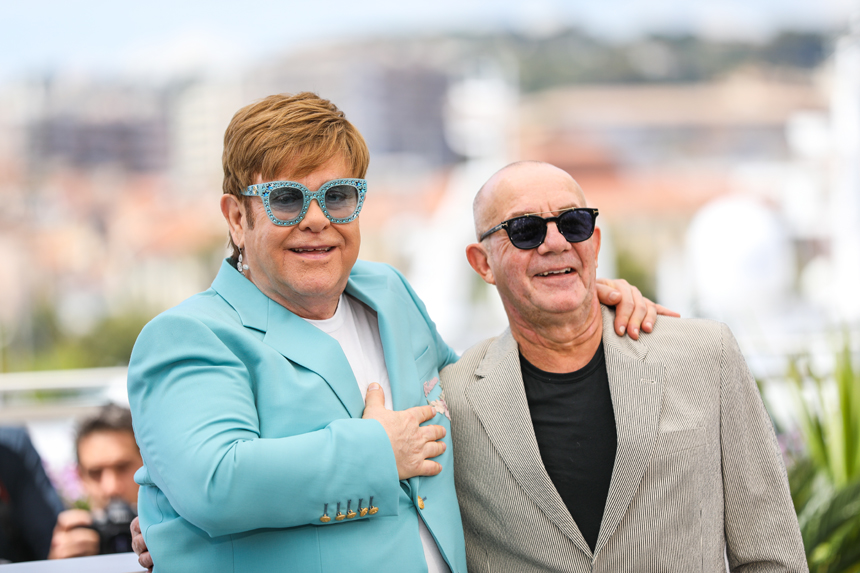When it comes to popular music, some metrics are easy to measure. From first live performance to first hit song to final tour, it’s not hard to pin down the specifics. But when you talk about impact, influence, and artistry, it becomes much harder to quantify. In the case of Elton John, one superlative isn’t as difficult to assess, and that’s because 1973’s Goodbye Yellow Brick Road is almost universally hailed as his greatest album. A commercial juggernaut that moved millions of albums and a musical statement that delivered some of Sir Elton’s best work, the album arrived 50 years ago this week. Here are five important pieces of the Road.
1. You Can’t Beat Bernie

Elton John (born Reginald Dwight) launched as a solo artist, but his career sprang from what would become one of the most successful partnerships in music. John and lyricist Bernie Taupin met in 1967 after they both answered a talent search ad from Liberty Records in New Musical Express. John admitted straightaway that he couldn’t write lyrics, sot he desk attendant at the record label, handed him a batch of lyrics, which included some pieces by Taupin. The nascent performer was struck by Taupin’s work; while they didn’t land anything at Liberty, they formed a team that worked on the simple premise of Taupin writing and John applying the melodies and music. With the exception of a tiny break at the end of the 1970s, the two have worked in tandem, producing a dizzying number of hit songs across six decades. Taupin wrote all of the lyrics for the album that would become Goodbye Yellow Brick Road in less than three weeks.
2. I See Jamaica, I See France
“Goodbye Yellow Brick Road” (Uploaded to YouTube by Elton John)
For his part, John put together the melodies and music for the album in Kingston, Jamaica. He’d been attracted to the spot because that’s where his friends, The Rolling Stones, made their album Goat’s Head Soup. Despite the success of the song “Angie,” Soup would be regarded as a lesser Stones record after their epic winning streak of the late ’60s/early ’70s. The region would sour for John shortly after he set to work on the record. A combination of fighting between different political factions in the country, issues with the equipment and instruments at the recording studio, and more forced John to abandon the country for France. Reseated at the same studio where he put down Don’t Shoot Me I’m Only the Piano Player and Honkey Château, John and his supporting musicians knocked out the album in two weeks.
3. The People Behind the Curtain
“Saturday Night’s Alright for Fighting” (Uploaded to YouTube by Elton John)
Gus Dudgeon, the record’s producer, was another frequent collaborator of John’s. Dudgeon was behind the board for John’s first huge hit, “Your Song,” and would helm numerous other albums. He also produced other classics like “She’s Not There” by The Zombies and David Bowie’s “Space Oddity.” Most of the musicians on the record, like synth player and engineer David Hentschel, drummer Nigel Olsson, percussionist Ray Cooper, bassist Dee Murray, sax player Leroy Gómez, and guitarist Davey Johnstone, recorded or toured with John several times. The orchestral arranger, Del Newman, worked with John and other big stars like Carly Simon and Rod Stewart. Kiki Dee provided background vocals on one song; three years later, she and John would have a massive #1 hit in both the U.S. and the U.K. with their duet, “Don’t Go Breaking My Heart.”
4. The Hits
Elton John performs “Bennie and the Jets” at Bonnaroo, 2014 (Uploaded to YouTube by Elton John)
The original release of Goodbye was in a double-album format. The songs were broken down into three on Side 1, five on Side 2, four on Side 3, and five on Side 4, totaling 17 tracks. The first single, the raucous “Saturday Night’s Alright for Fighting” was released in June as a lead-up to the album; it hit #12 in the U.S. and eventually racked up a Gold certification for sales exceeding 500,000 copies.
The title track followed in September. It reached #2 on Billboard’s Hot 100 and was a hit around the world. “Goodbye Yellow Brick Road” quadrupled the sales of “Saturday” and has become one of John’s (admittedly many) signature tunes. In interviews, Taupin has recounted that the song conveys a feeling of ditching the trappings of stardom and returning to a simpler life.
“Candle in the Wind” would become one of John’s most beloved songs. After finding success upon its original release, the Marilyn Monroe tribute returned to the charts in 1988 via a live version that John recorded in Sydney, Australia. After the passing of John’s good friend, Princess Diana, he reconfigured the lyrics as an ode to her with “Candle in the Wind 1997,” also known as “Goodbye England’s Rose.” That take held the #1 spot of Billboard’s Hot 100 for an astonishing 14 weeks and became the second best-selling single in history, exceeded only by Bing Crosby’s “White Christmas.”
The final single from the album hit airwaves in 1974. “Bennie and The Jets” wasn’t one of John’s own choices for a single, and he had to be persuaded to release it. In a rare instance of John being wrong about a song, he was rewarded with another #1 tune in the U.S. and sales in excess of 2.8 million 45s.
5. Numbers and Accolades
“Candle in the Wind” (Uploaded to YouTube by Elton John)
In the last 50 years, Goodbye Yellow Brick Road has amassed certified sales of 20 million copies worldwide, with estimated sales of 30 million. It’s been incredibly popular in the States, with eight million certified copies sold. This makes it far and away John’s best-selling studio album in a catalog that’s sold over 300 million records. In 2003, it was inducted into the Grammy Hall of Fame. The album sits at #112 of Rolling Stone’s list of the Greatest Albums of All Time. The opening track of the record, the non-single “Funeral for a Friend/Love Lies Bleeding,” has been a critical darling and was chosen as his second-best song in 2017 in Billboard’s multi-critic appraisal of his work. The four singles remained staples of John’s live act up through his retirement from the road in July of this year. That tour went by the appropriate name of “Farewell Yellow Brick Road.”
Become a Saturday Evening Post member and enjoy unlimited access. Subscribe now




Comments
And in 2023 Bernie Taupin was once again awarded Rock-n-Roll Hall of Fame recognition for his phenomenal work as a lyricist.
“Taupin received the Oscar for Best Original Song in 2020, along with John, for “(I’m Gonna) Love Me Again”[6] and was inducted into the Rock and Roll Hall of Fame in the Musical Excellence Award category in 2023.”(1)
(1) Source- Wikipedia
This unquestionably is John’s masterpiece (peak) album. He was already very popular in 1971 and ’72 in the U.S. but wasn’t “commercialized” until 1975, then overly so with the ‘Captain Fantastic’ album, which really wasn’t. Then being on the cover of TIME at the same time.
John’s ‘Caribu’ album in mid-1974 was really excellent, overlooked and underappreciated following ‘Road’ only 8 months later. I could have seen myself writing a record review of it for the high school paper in the 2nd semester of my junior year following Carly Simon’s ‘Hotcakes’ (her peak album) and Cat Steven’s ‘Buddha and the Chocolate Box’, but ‘Goodbye Yellow Brick Road’ would have been too much at 16 1/2, even for me. Very grateful I got to write those two. (My friend wrote a good review too, but it was for the film ‘Dirty Mary and Crazy Larry.’)
Thank you for including ‘Saturday Night’s Alright For Fighting’ here. I remember hearing it before ‘Road’ came out, and being shocked and astonished in a good way, of course. Dissecting it alone would have been a real challenge. I don’t think most people have any idea what an extremely intricate, difficult song that was/is to sing. Only Elton John could have done it.
‘Funeral For A Friend/Love Lies Bleeding’ may be the most brilliant of all from the album. Very few songs are two in one, or run for 11 minutes. For all the appreciation the music industry seems to lavish on it today, these same people would throw Elton John and Bernie Taupin out of their offices if they were starting out now, not having a chance in hell of getting a record contract. It isn’t a corporate/AI reshuffling of the same deck of cards for the millionth time. Everything’s so broken and all-over-with, I’d hate being 16/17 now. No. 1973-’74 with Watergate and its other shortcomings, still had great music, TV shows, films, beautiful low/sleek Monte Carlos, Dodge Chargers on the streets and no never-ending pandemics soon going into a fifth year.
I’m a bit nostalgic but, I believe his album(1st?) with 60 years on, etc., was his best. He and Taupin made a marvelous album together that rarely gets any play on the airwaves. I did have that fabulous recording a long time ago.